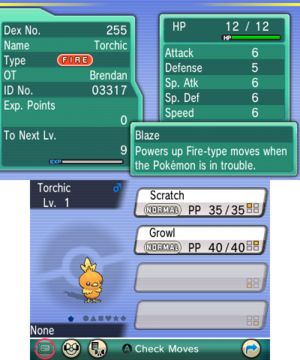Trainer ID number: Difference between revisions
Unowninator (talk | contribs) (Secret ID for VC transfers; does it exist?) |
m (→In other languages: added Swedish and Danish from Emerald manual) |
||
| Line 28: | Line 28: | ||
|zh_yue=ID No. | |zh_yue=ID No. | ||
|zh_cmn=ID No. | |zh_cmn=ID No. | ||
|da=ID-nummer | |||
|fr={{tt|Nº|Numéro}} ID | |fr={{tt|Nº|Numéro}} ID | ||
|de=ID-Nummer | |de=ID-Nummer | ||
| Line 33: | Line 34: | ||
|ko=IDNo. | |ko=IDNo. | ||
|es={{tt|N.º|Número}} ID | |es={{tt|N.º|Número}} ID | ||
|sv=ID-nummer | |||
}} | }} | ||
{{-}} | {{-}} | ||
Revision as of 07:31, 9 January 2018

|
This article is incomplete. Please feel free to edit this article to add missing information and complete it. Reason: Secret ID for VC transfers. Does it exist? |

A Pokémon Trainer's ID number (Japanese: IDNo.) is a number that is assigned to a Trainer when they begin their Pokémon journey. It is used, in conjunction with the Trainer's name and gender, to identify whether the Pokémon is an outsider Pokémon by the games.
Prior to Generation VII, Trainers have a five-digit number ranging from 0 to 65535. In Generation VII, Trainers have a six-digit number.
Special ID numbers
- Main article: List of notable ID numbers
Sometimes, there are special ID numbers assigned to Pokémon if they come from a non-standard Pokémon game or are received as a prize. Also, for Pokémon not yet hatched from their Eggs, the ID ????? is used. It will turn into the ID number of the Trainer who hatches the Pokémon. It is also used for unpurified Shadow Pokémon. Once purified, the ID number will change to that of the Trainer who snagged it.
Secret ID
From Generation III onward, there is a second, secret ID number, different from the visible one. This number exists purely to make sure that even if two Trainers share the exact same name and gender and the exact same Trainer ID number, the game will still recognize their Pokémon as coming from different Trainers. Usually, this number cannot be viewed; however, certain cheating devices can be used to view it, and there are also calculators to determine it. It also comes into play along with the normal ID number and the personality value in determining if a Pokémon is Shiny. If two different Trainers have the same Trainer name, identical ID numbers and identical hidden ID numbers (a 1 in 4,294,967,296 chance if the names do not differ), the game will recognize the two Trainers as the same, so the Pokémon are not considered to be outsider Pokémon.
Generation VII
From Generation VII onward, the ID number is a six-digit number. A five-digit Trainer ID and a five-digit Secret ID are still generated but are not displayed on the Trainer Card directly. Rather, they are used to calculate the final ID number by using the following formula: IDfinal = IDtrainer + IDsecret × 65536. The last six digits of the resulting number are what is displayed when the Trainer Card is viewed.
For example, consider a new save file in which the player is assigned Trainer ID and Secret ID are 00033 and 34262 respectively. The final ID number will be 33 + 34262*65536 = 2245394465. However, only the last six digits are used so the Trainer Card will display an ID No. of 394465.
If a Pokémon is transferred to Generation VII from a previous generation, its Trainer's ID number will remain 5 digits long.
Pokémon Lottery Corner
- Main article: Pokémon Lottery Corner
Once per week in Generation II and once per day in Generations III, IV, VI, and VII, the player may take part in the Pokémon Lottery Corner. This involves the generation of a random 5 digit number, which is compared with the player's Pokémon's original Trainer's ID numbers. Depending on the game and the nature of the match-up of digits, the player can receive a prize. This feature was not included in the Generation V games, but returned in the X and Y games as the Loto-ID in Lumiose City.
In other languages
| ||||||||||||||||||||||||||||||||

|
This game mechanic article is part of Project Games, a Bulbapedia project that aims to write comprehensive articles on the Pokémon games. |